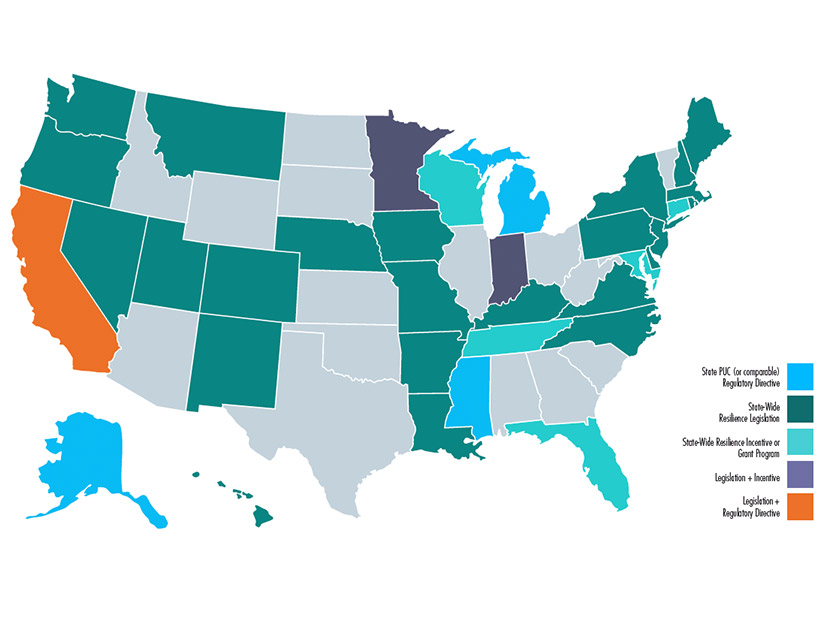Energy resilience is an essential but still poorly understood concept, and considerable work is needed from all industry stakeholders in order to properly appreciate its value, according to a recent white paper from the Electric Power Research Institute (EPRI).
The organization published the “Value of Resilience” white paper both to highlight the importance of resilience — defined as “the ability to withstand and reduce the magnitude and/or duration of disruptive events,” according to FERC — and to warn that efforts to address the issue in the bulk power system have fallen far short of society’s needs.
Resilience and reliability — the latter of which the paper defines as “preparedness for challenges the system has historically faced” — are often conflated in the minds of both grid planners and society in general. But there are key differences; most notably, that resilience planning incorporates the impact of all threats, including those that have not been encountered before.
Major Weather Incidents on the Rise
Planning for unforeseen impacts is an undeniably challenging task, but it is also unavoidable in light of the growing incidence of high-cost extreme weather events over the last 40 years: EPRI cites data from the National Oceanic and Atmospheric Administration showing 22 billion-dollar disaster events in 2020, up from just three in 1980 (adjusted for inflation). February’s winter storm, which caused multiple megawatts of generation to trip offline in Texas and left 2.8 million ERCOT customers without power at the peak of the crisis, indicates that this trend is likely to continue. (See ERCOT was ‘Seconds and Minutes’ from Total Collapse.)
The February “outage event is the most recent event to highlight the need for resilience planning,” the paper says. “Human perception of resilience is based largely on experience, and it’s likely that individuals living in Texas now perceive resilience very differently than prior to February 2021.”
However, even when the need for resilience planning is clear, reaching that goal is still a challenge. While a number of metrics exist for power system reliability — such as system average interruption duration and frequency indices (SAIDI and SAIFI, respectively), operating and planning reserve margins, and estimated unserved load — no such metrics have been described for resilience. This makes it difficult to predict the effectiveness of proposed resilience measures or to decide which should be given priority.
EPRI notes that some reliability metrics “may be indicators of resilience as well” but warns that changing climate and weather patterns, a rapidly evolving generation resource mix, and expansion in the use of electricity for transportation and heating mean utilities will need to be careful how they apply these measurements.
“Cost methods are typically retrospective and do not account for chronic, far-reaching impacts we are experiencing today,” Katie Jereza, vice president for corporate affairs at EPRI, said in the paper. “If extreme events intensify, we will be even further behind the curve. We need to focus on making tomorrow’s grid more resilient rather than fixing yesterday’s.”
Roles for Utilities, Customers and Regulators
Suggestions of useful resilience metrics are not to be found in the white paper, which acknowledges that the stage of research into such valuation approaches is too early to be helpful. Instead, EPRI casts its report as a “foundational guide” to such research for academia and research organizations, as well as industry stakeholders such as utilities and state and federal regulators.
The role of research organizations includes developing frameworks and models to analyze resilience that take into account the changing energy landscape; this can benefit smaller utilities, which may not have the resources to devote to such models. Researchers can also collaborate with small utilities to develop and perform customer surveys to evaluate losses from outages.
Residential, industrial and commercial customers have a role to play in resilience planning as well, by providing insight into their use of electricity that can determine which functions are most critical and should be restored first in an outage. This information may be especially important in situations like the COVID-19 pandemic, which led to an unprecedented amount of employees working from home in 2020, all of them needing electricity to keep connected to their virtual workplaces.
Because utilities may find it hard to justify investing in resilience measures with no apparent short-term profit, regulators may also need to step in to encourage such moves. This can take the form of financial incentives — such as those proposed by FERC last year for cybersecurity investments — or mandatory requirements. (See FERC Pushes Cybersecurity Incentives.) EPRI noted that regulatory resilience activities vary widely across the U.S., including directives from state public utility commissions, resilience legislation, incentives or a mixture. Many states have no resilience measures in place at all.
“We witness resilience in practice every day but may recognize the critical role it plays only in the face of things that test it,” EPRI said. “More importantly, it is often those tests of our resilience that allow us to understand when and where we are vulnerable and give us the opportunity to better prioritize and prepare for the next time.”





